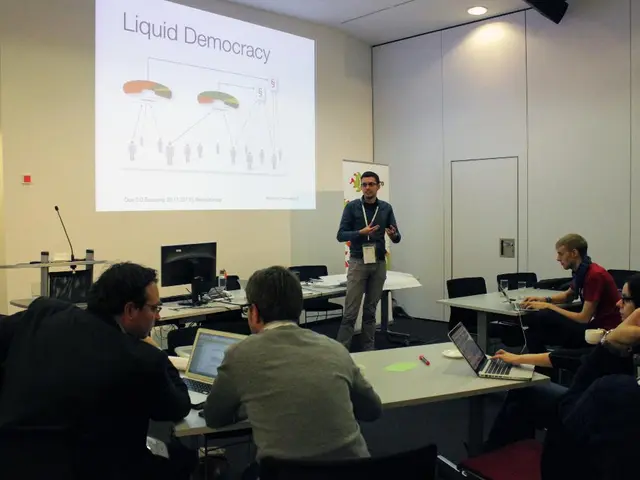Harnessing Magnetism for Global Energy: A Look into Tomorrow's Power Sources
In the pursuit of sustainable energy solutions, the focus on magnetism-based energy systems has been growing. Researchers are working tirelessly to develop new magnetic materials with improved performance and efficiency, offering high efficiency, versatility, and low environmental impact.
Magnetism-based energy systems harness the power of magnetic fields to induce electrical currents in conductors. One such method is Induction electromagnétique, which generates electricity through electromagnetic induction. Another promising technique is Magnetohydrodynamics (MHD), which generates electricity from the motion of fluids, such as seawater, using magnetic fields.
One of the most attractive options for grid-scale energy storage is Superconducting Magnetic Energy Storage (SMES). SMES stores electrical energy with high efficiency in a magnetic field using superconducting materials. In coastal communities, SMES can be used to generate electricity from seawater, making it a promising option for these regions.
However, challenges in magnetism-based energy, including cost, materials, and scalability, remain. These issues are being addressed through advancements in fusion energy, the growing role of powerful rare-earth magnets in renewable technologies, and innovations in magnet recycling to support circular economy goals.
Recent fusion energy progress includes Realta Fusion's computational modeling of magnetic mirror fusion reactors predicting commercially viable energy gains, rivaling more conventional magnetic confinement schemes like tokamaks. This advances magnet-based plasma confinement crucial for practical fusion power generation. Similarly, ITER’s completion of the massive, superconducting central solenoid—a key magnet for plasma containment in tokamak reactors—demonstrates engineering feats enabling sustained fusion reactions at extreme temperatures necessary for clean energy production.
Powerful rare-earth magnets, especially neodymium-iron-boron (NdFeB), are pivotal in electric vehicles (EVs) and wind turbines, driving the transition to clean energy by improving motor and generator efficiency. The global NdFeB magnet market is projected to grow significantly, doubling from $20.37 billion in 2025 to $37.18 billion by 2032, fueled by expanding renewable energy and EV sectors. However, environmental concerns related to rare earth mining and processing have spurred interest in stricter regulations, development of alternative magnetic materials, and recycling technologies.
Innovations in magnet recycling are critical for sustainability. Emerging methods such as Hydrogen Processing of Magnetic Scrap (HPMS) chemically reduce NdFeB magnets into reusable powders, enabling recovery of valuable rare earths with less environmental impact than traditional high-energy or hazardous solvent processes. Companies like HyProMag in the UK are advancing commercial-scale recycling plants. Green solvents and ionic liquids also offer more eco-friendly extraction methods, supporting circular material flows.
Looking ahead, the future prospects for magnetism-based energy systems emphasize fusion energy commercialization through improved magnetic confinement designs, growth in magnet demand driven by EVs and renewable infrastructure, and enhanced recycling and circular economy strategies. Together, these advancements indicate a robust pathway where magnetism-based technologies will play a central role in achieving sustainable, large-scale clean energy generation in the coming decades.
[1] Realta Fusion. (2021). Realta Fusion achieves key milestone in magnetic mirror fusion reactor project. Retrieved from https://realtafusion.com/news/realta-fusion-achieves-key-milestone-in-magnetic-mirror-fusion-reactor-project
[2] Grand View Research. (2021). Neodymium Iron Boron (NdFeB) Magnets Market Size, Share & Trends Analysis Report By Application, By Region And Segment Forecasts, 2021 - 2028. Retrieved from https://www.grandviewresearch.com/industry-analysis/neodymium-iron-boron-magnets-market
[3] ITER. (2021). ITER completes the central solenoid. Retrieved from https://www.iter.org/news/iter-completes-central-solenoid
[4] HyProMag. (2021). HyProMag secures £10.3m funding for commercial-scale rare earth magnet recycling plant. Retrieved from https://www.hyromag.com/hypromag-secures-10-3m-funding-for-commercial-scale-rare-earth-magnet-recycling-plant/
[5] McKinsey & Company. (2021). The rare-earth market: A look at the supply-chain dynamics. Retrieved from https://www.mckinsey.com/industries/automotive-and-assembly/our-insights/the-rare-earth-market-a-look-at-the-supply-chain-dynamics
- The growth in magnetism-based energy is stimulated by the development of new magnetic materials, such as those used in Induction electromagnétique, Magnetohydrodynamics, and Superconducting Magnetic Energy Storage (SMES), which offer high efficiency, versatility, and low environmental impact.
- The global NdFeB magnet market is projected to increase significantly due to the expanding renewable energy and electric vehicle sectors, driven by the crucial role of powerful rare-earth magnets like NdFeB in electrical vehicle motors and wind turbine generators.
- Innovations in magnet recycling, such as Hydrogen Processing of Magnetic Scrap (HPMS) and the use of green solvents and ionic liquids, are addressing environmental concerns related to rare earth mining and processing, supporting the transition to a circular economy and sustainable magnet use.
- The future of magnetism-based energy emphasizes fusion energy commercialization through improved magnetic confinement designs, growth in magnet demand driven by electrification and renewable infrastructure, and enhanced recycling and circular economy strategies, indicating a robust pathway for magnet-based technologies in large-scale clean energy generation.




